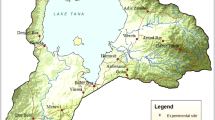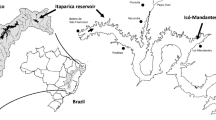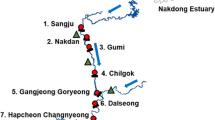Abstract
Eichhornia crassipes and Monochoria vaginalis are waterweeds, and their uncontrolled proliferation in fresh and brackish water habitats is a serious ecological problem in many parts of the world. These weeds are quite common in the Vembanad Lake System (VLS), India’s second-largest Ramsar wetland. During the non-monsoon season, the Thannermukkom saltwater barrage divides the VLS into two zones: saline water downstream and freshwater upstream. The field sampling of the current study was carried out in the upstream zone of the VLS during the Pre-Monsoon (March 2017). Fresh Eichhornia and Monochoria samples were collected, transported to the lab, and experiments were conducted under natural light conditions to determine how much extra water they transpire into the atmosphere. The results showed that the water loss in experimental tanks with Eichhornia (evapotranspiration) is roughly twice that in control tanks without them (only evaporation). Monochoria transpires fairly more water to the atmosphere than Eichhornia. These results reveal that the proliferation of waterweeds has a significant adverse effect in conserving water in all freshwater bodies infested with them. The current study also points out that the expansion of waterweeds has the potential to worsen drought conditions as they cause excess water loss into the atmosphere and a faster drying up of freshwater reservoirs. Two possible approaches for managing the waterweeds in the VLS include reducing nutrient loading upstream and more frequent opening of the Thannermukkom saltwater barrage to allow saltwater intrusion, which could inhibit the growing waterweeds.






Similar content being viewed by others
Availability of data and materials
The data sets used and/or analysed during the current study are available from the corresponding author on reasonable request through the Director, CSIR-National Institute of Oceanography, or the Scientist-in-Charge, Regional Centre Kochi.
References
Akendo, I. C., Gumbe, L. O., & Gitau, A. N. (2008). Dewatering and Drying Characteristics of Water Hyacinth (Eichhornia crassipes) Petiole. Part I. Dewatering Characteristics. Agricultural Engineering International: CIGR Journal. 1–11.
Anjusha, A., Jyothibabu, R., Jagadeesan, L., & Arunpandi, N. (2018). Role of rotifers in microzooplankton community in a large monsoonal estuary (Cochin backwaters) along the west coast of India. Environmental Monitoring and Assessment, 190(5), 1–24.
Arun, A. U. (2005). An assessment on the influence of salinity in the growth of black clam (Villorita cyprinoides) in cage in Cochin Estuary with a special emphasis on the impact of Thanneermukkom salinity barrier. ACCL Bioflux (Int. J. Bioflux Soc.) 2, 433–447.
Arunpandi, N., Jyothibabu, R., Jagadeesan, L., Albin, K. J., Savitha, K. M. M., & Parthasarathi, S. (2020a). Impact of salinity on the grazing rate of a cladocera (Latonopsis australis) in a large tropical estuarine system. Environmental Monitoring and Assessment, 192(2), 1–13. https://doi.org/10.1007/s10661-020-8068-x
Arunpandi, N., Jyothibabu, R., Jagadeesan, L., Parthasarathi, S., Albin, K. J., & Pandiyarajan, R. S. (2020b). Impact of a large hydraulic barrage on the trace metals concentration in mesozooplankton in the Kochi backwaters, along the southwest coast of India. Marine Pollution Bulletin, 160, Article 111568. https://doi.org/10.1016/j.marpolbul.2020b.111568
Arunpandi, N., Jyothibabu, R., Savitha, M. K. M., Parthasarathi, S., Rashid, C. P., Josna, M. P., & Balachandran, K. K. (2021a). Trace metals concentration in water hyacinth implicates the saltwater barrage altered hydrography of Kochi backwaters, southwest Coast of India. Marine Pollution Bulletin, 168, 112447. https://doi.org/10.1016/j.marpolbul.2021a.112447
Arunpandi, N., Jyothibabu, R., Jagadeesan, L., Parthasarathi, S., Anjusha, A., & Albin, K. J. (2021b). Impact of human-altered hydrographical setting on the copepod community structure in an extensive tropical estuary along the southwest coast of India. Oceanologia, 63(1), 115–132. https://doi.org/10.1016/j.oceano.2020.10.004
Arunpandi, N., Jyothibabu, R., Jagadeesan, L., Parthasarathi, S., Savitha, M. K. M., Albin, K. J., & Pandiyarajan, R. S. (2021c). Implications of an extensive salt water barrage on the distribution of black clam in a tropical estuarine system, Southwest coast of India. Oceanologia, 63, 343–355. https://doi.org/10.1016/j.oceano.2021.03.005
Balachandran, K. K., Reddy, G. S., Revichandran, C., Srinivas, K., Vijayan, P. R., & Thottam, T. J. (2008). Modelling of tidal hydrodynamics for a tropical ecosystem with implications for pollutant dispersion (Cohin Estuary, Southwest India). Ocean Dynamics, 58(3), 259–273.
Balchand, A. N. (1983). Kuttanad: A case study on environmental consequences of water resources mismanagement. Water International, 8(1), 35–41.
Bick, E., de Lange, E. S., Kron, C. R., da Silva Soler, L., Liu, J., & Nguyen, H. D. (2020). Effects of salinity and nutrients on water hyacinth and its biological control agent, Neochetina bruchi. Hydrobiologia, 847, 3213–3224.
Blanco, F. F., & Folegatti, M. V. (2003). Evapotranspiration and crop coefficient of cucumber in greenhouse. Revista Brasileira De Engenharia Agrícola e Ambiental, 7, 285–291.
Calvert, P. (2002). Water hyacinth control and possible uses. Technical Brief International Technology Development Center, UK. Available at http://ow.ly/TjgpJ
Cheng, J. (2004). The Effects of Salinity on Water Hyacinth (Eichhonia crassipes). Senior Thesis for Environmental Science, University of California: Berkeley, 196.
Dinesh Kumar, P. K. (1997). Cochin backwaters: A sad story of manipulation. Ambio, 24, 249–250.
Frezina, N. C. A. (2013). Assessment and utilization of water hyacinth in the water bodies of Tamil Nadu. International Journal of Scientific Research and Reviews, 2(1), 58–77.
Ghosh, D. (2010). Water hyacinth, befriending the noxious weed. Science Reporter, 47(12), 46–48.
Gopal, B. (1987). Water hyacinth, aquatic plant (p. 471). Elsevier Science Publishers, B. V.
Haridevan, G., Jyothibabu, R., Arunpandi, N., Jagadeesan, L., & Biju, A. (2015). Influence of salinity on the life table demography of a rare Cladocera Latonopsis australis. Environmental Monitoring and Assessment, 187(10), 1–15.
Imaoka, T., & Teranishi, S. (1988). Rates of nutrient uptake and growth of the water hyacinth [Eichhornia crassipes (Mart.) Solms]. Water research, 22(8), 943–951.
Imchen, T., Sawant, S. S., & Ezaz, W. (2017). Exposure of Eichhornia crassipes (Mart.) Solms to salt water and its implications. Current Science, 113 (1), 439–443.
Jyothibabu, R., Madhu, N. V., Jayalakshmi, K. V., & Balachan-dran, K. K., Shiyas, C. A., Martin, G. D., & Nair, K. K. C. (2006). Impact of freshwater influx on microzooplankton mediated food web in a tropical estuary (Cochin backwaters- India). Estuarain Coast and Shelf Science, 69(3–4), 505–518. https://doi.org/10.1016/j.ecss.2006.05.013
Kurup, B. M., Sebastian, M. J., Sankaran, T. M., & Rabindranath, P. (1990). Impact of Thannirmukham barrier on the fishery resources of the Vembanad lake. In Proc. Second Kerala Science Congress, Trivandrum 194-198.
Madhu, N. V., Jyothibabu, R., Balachandran, K. K., Honey, U. K., Martin, G. D., & Vijay, J. G. (2007). Monsoonal impact on planktonic standing stock and abundance in a tropical estuary (Cochin Backwaters-India). Estuarine, Coastal and Shelf Science, 73, 54–64.
Mathiventhan, T., Jayasingam, T., & Umaramani, M. (2018). Salinity would be an option to control Eichhornia crassipes (Mart.) Solms [Water Hyacinth]: Sri Lanka perspective. Tropical Plant Research, 5(3), 331–335.
Menon, N. N., Balchand, A. N., & Menon, N. R. (2000). Hydrobiology of the Cochin backwater system - A review. Hydrobiologia, 430(1), 149–183.
Morton, F. I. (1983). Operational estimates of areal evapotranspiration and their significance to the science and practice of hydrology. Journal of Hydrology, 66(1–4), 1–76.
Muramoto, S., Aoyama, I., & Oki, Y. (1991). Effect of salinity on the concentration of some elements in water hyacinth (Eichhornia crassipes) at critical levels. Journal of Environmental Science & Health Part A, 26(2), 205–215.
Osmond, R., & Petroeschhevsky, A. (2013). Water hyacinth Control Modules Control options for water hyacinth (Eichhornia crassipes) in Australia. Australia: New South Wales Department of Primary Industries. Retrieved from: https://www.dpi.nsw.gov.au/__data/assets/pdf_file/0005/505706/waterhyacinth-control-modules-full-accessible.pdf
Rezania, S., Ponraj, M., Din, M. F. M., Songip, A. R., Sairan, F. M., & Chelliapan, S. (2015). The diverse applications of water hyacinth with main focus on sustainable energy and production for new era: An overview. Renewable and Sustainable Energy Reviews, 41, 943–954.
Rotella, A. R. (2010). Growth and biomass of water hyacinth in a tidal blackwater river system, South Carolina. Diss. Coastal Carolina University. Electronic Theses and Dissertations, 72. https://digitalcommons.coastal.edu/etd/72
Shivaprasad, A., Vinita, J., Revichandran, C., Manoj, N. T., Srinivas, K., Reny, P. D., Ashwini, R., & Muraleedharan, K. R. (2012). Influence of saltwater barrage on tides, salinity, and Chlorophyll a in Cochin Estuary. India Journal of Coastal Research, 29(6), 1382–1390.
Unni, P. N., & Nair, S. R. (1995). Environmental issues in Vembanad estuary due to salinity and flood control structures. In The 9th 1995 Conference on Coastal Zone, Tampa, FL, USA, 07/16-21/95.
Van der Weert, R., & Kamerling, G. E. (1974). Evapotranspiration of water hyacinth (Eichhornia crassipes). Journal of Hydrology, 22(3–4), 201–212.
Villamagna, A., & Murphy, B. (2010). Ecological and socio-economic impacts of invasive water hyacinth (Eichhornia crassipes): A review. Freshwater Biology, 55, 282–298. https://doi.org/10.1111/j.1365-2427.2009.02294
Acknowledgements
The authors thank the Director of the CSIR-National Institute of Oceanography for the facility and encouragement. The study on waterweeds in the VLS was initiated as part of the OCEAN FINDER programme of CSIR-NIO and the present work was completed in association with the SWQM programme of the Ministry of Earth Sciences, New Delhi. This is a contribution of CSIR-NIO 6901.
Funding
This study received funding from the CSIR-NIO (OCEAN FINDER Project), Goa, India.
Author information
Authors and Affiliations
Contributions
AN: conceptualization; investigation; writing—original draft; funding acquisition; project administration; JR: conceptualization; investigation; visualisation; formal analysis; supervision and funding acquisition; DP: conceptualization; investigation; visualisation; formal analysis; JL: investigation; visualisation; formal analysis; R.C.P: investigation; visualisation; SS: investigation; visualisation.
Corresponding author
Ethics declarations
Competing interests
The authors declare no competing interests.
Additional information
Publisher's Note
Springer Nature remains neutral with regard to jurisdictional claims in published maps and institutional affiliations.
Supplementary Information
Below is the link to the electronic supplementary material.
Rights and permissions
About this article
Cite this article
Arunpandi, N., Jyothibabu, R., Dhanya, P. et al. Alarming waterweeds proliferation in the Vembanad Lake System might significantly increase water loss through transpiration. Environ Monit Assess 194, 303 (2022). https://doi.org/10.1007/s10661-022-09938-1
Received:
Accepted:
Published:
DOI: https://doi.org/10.1007/s10661-022-09938-1




